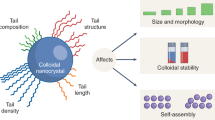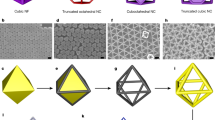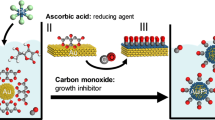Abstract
One of the key challenges in materials science is to control the size and shape of inorganic nanoparticles with a high degree of precision, as these parameters have a significant influence on the nanoparticles' properties and potential applications. Here, we describe the preparation of highly monodisperse silica nanoparticles smaller than 5 nm in diameter by using self-assembled, hollow, spherical compounds as ‘endo-templates’. These coordination complexes with pendant sugar groups lining their interiors—assembled from 12 metal ions and 24 bis-pyridyl ligands containing glucose substituents—acted as structurally well-defined templates for the sol–gel condensation of alkoxysilanes. The polydispersities of the silica nanoparticles made with this method approached unity, with Mw/Mn < 1.01. The component ligands are modified easily, which enables an accurate expansion of the coordination complex and the subsequent control of the monodisperse silica nanoparticles that span molecular weights of 5,000 to 31,000 Da (corresponding to 2–4 nm in diameter). This method could be applicable to the preparation of other inorganic nanoparticles.
This is a preview of subscription content, access via your institution
Access options
Subscribe to this journal
Receive 12 print issues and online access
$259.00 per year
only $21.58 per issue
Buy this article
- Purchase on Springer Link
- Instant access to full article PDF
Prices may be subject to local taxes which are calculated during checkout




Similar content being viewed by others
References
Alivisatos, A. P. Semiconductor clusters, nanocrystals, and quantum dots. Science 271, 933–937 (1996).
Schmid, G. Nanoparticles: from Theory to Application (Wiley-VCH, 2004).
White, R. J., Luque, R., Budarin, V. L., Clark, J. H. & Macquarrie, D. J. Supported metal nanoparticles on porous materials. Methods and applications. Chem. Soc. Rev. 38, 481–494 (2009).
Joo, S. H. et al. Ordered nanoporous arrays of carbon supporting high dispersions of platinum nanoparticles. Nature 412, 169–172 (2001).
Fröba, M., Köhn, R., Bouffaud, G., Richard, O. & van Tendeloo, G. Fe2O3 nanoparticles within mesoporous MCM-48 silica: in situ formation and characterization. Chem. Mater. 11, 2858–2865 (1999).
Yang, B., Kamiya, S., Yoshida, K. & Shimizu, T. Confined organization of Au nanocrystals in glycolipid nanotube hollow cylinders. Chem. Commun. 500–501 (2004).
Hermes, S. et al. Metal@MOF: loading of highly porous coordination polymers host lattices by metal organic chemical vapor deposition. Angew. Chem. Int. Ed. 44, 6237–6241 (2005).
Pileni, M. P. Reverse micelles as microreactors. J. Phys. Chem. 97, 6961–6973 (1993).
Kortan, A. R. et al. Nucleation and growth of CdSe on ZnS quantum crystallite seeds, and vice versa, in inverse micelle media. J. Am. Chem. Soc. 112, 1327–1332 (1990).
Osseo-Asare, K. & Arriagada, F. J. Preparation of SiO2 nanoparticles in a non-ionic reverse micellar system. Colloids Surf. 50, 321–339 (1990).
Esquena, J., Tadros, Th. F., Kostarelos, K. & Solans, C. Preparation of narrow size distribution silica particles using microemulsions. Langmuir 13, 6400–6406 (1997).
Dickerson, M. B., Sandhage, K. H. & Naik, R. R. Protein- and peptide-directed syntheses of inorganic materials. Chem. Rev. 108, 4935–4978 (2008).
Vriezema, D. M. et al. Self-assembled nanoreactors. Chem. Rev. 105, 1445–1489 (2005).
Douglas, T. & Young, M. Host–guest encapsulation of materials by assembled virus protein cages. Nature 393, 152–155 (1998).
Douglas, T. et al. Protein engineering of a viral cage for constrained nanomaterials synthesis. Adv. Mater. 14, 415–418 (2002).
McMillan, R. A. et al. Ordered nanoparticle arrays formed on engineered chaperonin protein templates. Nature Mater. 1, 247–252 (2002).
Chasteen, N. D. & Harrison, P. M. Mineralization in ferritin: an efficient means of iron storage. J. Struct. Biol. 126, 182–194 (1999).
Meldrum, F. C., Wade, V. J., Nimmo, D. L., Heywood, B. R. & Mann, S. Synthesis of inorganic nanophase materials in supramolecular protein cages. Nature 349, 684–687 (1991).
Ueno, T. et al. Size-selective olefin hydrogenation by a Pd nanocluster provided in an apo-ferritin cage. Angew. Chem. Int. Ed. 43, 2527–2530 (2004).
Tominaga, M. et al. Finite, spherical coordination networks that self-organize from 36 small components. Angew. Chem. Int. Ed. 43, 5621–5625 (2004).
Kamiya, N., Tominaga, M., Sato, S. & Fujita, M. Saccharide-coated M12L24 molecular spheres that form aggregates by multi-interaction with proteins. J. Am. Chem. Soc. 129, 3816–3817 (2007).
Tominaga, M., Suzuki, K., Murase, T. & Fujita, M. 24-Fold endohedral functionalization of a self-assembled M12L24 coordination nanoball. J. Am. Chem. Soc. 127, 11950–11951 (2005).
Sato, S. et al. Fluorous nanodroplets structurally confined in an organopalladium sphere. Science 313, 1273–1276 (2006).
Suzuki, K., Kawano, M., Sato, S. & Fujita, M. Endohedral peptide lining of a self-assembled molecular sphere to generate chirality-confined hollows. J. Am. Chem. Soc. 129, 10652–10653 (2007).
Van Bommel, K. J. C., Friggeri, A. & Shinkai, S. Organic templates for the generation of inorganic materials. Angew. Chem. Int. Ed. 42, 980–999 (2003).
Yamaguchi, K. Cold-spray ionization mass spectrometry: principle and applications. J. Mass Spectrom. 38, 473–490 (2003).
Stöber, W., Fink, A. & Bohn, E. Controlled growth of monodisperse silica spheres in the micron size range. J. Colloid Interface Sci. 26, 62–66 (1968).
Acknowledgements
We thank M. Kawano for supporting the synchrotron X-ray crystallographic analysis at Photon Factory-Advanced Ring for Pulse X-rays of the High Energy Accelerator Research Organization. This work was supported by the Core Research for Evolution Science and Technology project of the Japan Science and Technology Agency, for which M.F. is the principal investigator, and also in part by the Global COE Program (Chemistry Innovation through Cooperation of Science and Engineering), Ministry of Education, Culture, Sports, Science and Technology (MEXT), Japan. A part of this work was conducted in the Center for Nano Lithography & Analysis, The University of Tokyo, supported by MEXT, Japan. This work was approved by the Photon Factory Program Advisory Committee.
Author information
Authors and Affiliations
Contributions
M.F. designed and directed the project and wrote the manuscript. K.S. performed the experimental work and wrote the manuscript. S.S. contributed to the data analysis.
Corresponding author
Ethics declarations
Competing interests
The authors declare no competing financial interests.
Supplementary information
Supplementary information
Supplementary information (PDF 6462 kb)
Rights and permissions
About this article
Cite this article
Suzuki, K., Sato, S. & Fujita, M. Template synthesis of precisely monodisperse silica nanoparticles within self-assembled organometallic spheres. Nature Chem 2, 25–29 (2010). https://doi.org/10.1038/nchem.446
Received:
Accepted:
Published:
Issue Date:
DOI: https://doi.org/10.1038/nchem.446
This article is cited by
-
Dye-doped silica nanoparticles: synthesis, surface chemistry and bioapplications
Cancer Nanotechnology (2020)
-
Chemical reactivity under nanoconfinement
Nature Nanotechnology (2020)
-
Strategies for binding multiple guests in metal–organic cages
Nature Reviews Chemistry (2019)
-
A [13]rotaxane assembled via a palladium molecular capsule
Nature Communications (2019)
-
Atomically precise organomimetic cluster nanomolecules assembled via perfluoroaryl-thiol SNAr chemistry
Nature Chemistry (2017)



